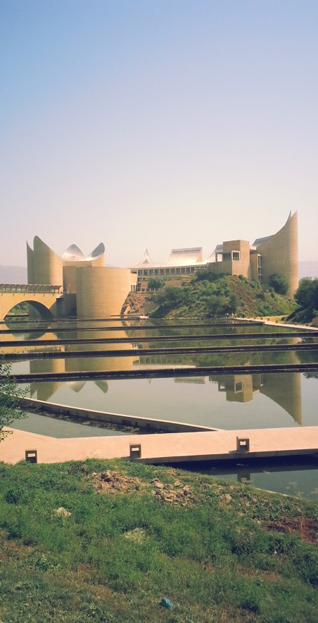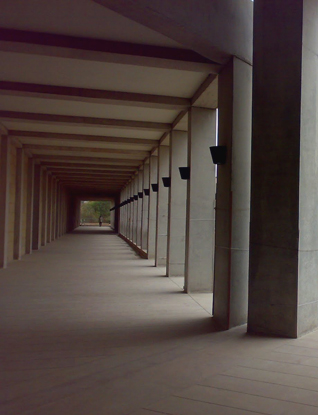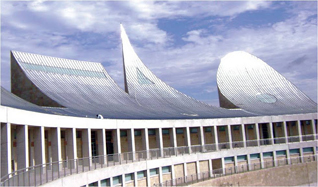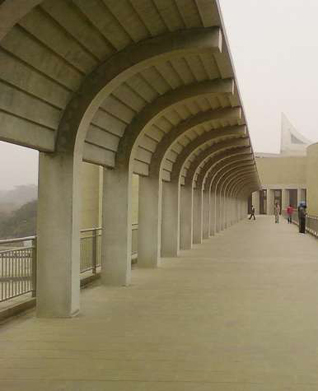Travel
A Visit to The Virasat-e-Khalsa
Dr JOGISHWAR SINGH
I have just returned from a visit to India, especially to Punjab, accompanied by my wife, my younger son and his fiancée, all non-Sikhs.
I being a Sikh, they all accompanied me to the Darbar Sahib in Amritsar, Sisganj Sahib in Delhi and Takht Sri Kesgarh Sahib at Anandpur Sahib.
Every visit to Sikh holy places is an occasion for me to recharge my spiritual batteries. It was the same this time. It was also the first time that my son and his fiancée saw Sikh gurdwaras animated by a devout sangat.
Punjab these days seems to be the source of disturbing news: widespread drug use by its youth, general public disgust with the two principal political parties perceived to be equally corrupt, rampant youth unemployment, an arrogant bureaucracy totally devoid of any feeling of service to the people, and a thoroughly corrupt police force indulging in killing of youth in fake encounters.
However, our visit to Anandpur Sahib did provide a ray of hope.
We had never visited the Sikh Heritage Centre known as the Virasat-e-Khalsa. We did so this time.
I found the place surprisingly good. The purpose of this article is to encourage more visitors to the Punjab to make a visit to the Virasat-e-Khalsa an integral part of their local itinerary.
The positive surprises began already at the very start of our visit. The entrance to the museum is free. Visitors do need to get the name of a group leader registered at a counter but the entry is free. Unlike most structures constructed or repaired by gurdwara committees and/or kaar seva babas who seem to equate the majesty of Sikhi not with simplicity and humility but with the quantity of marble and gold plastered on all structures, the Virasat-e-Khalsa structure is not encumbered either by marble or by gold plates.
It was such a relief to see a building dedicated to Sikh heritage not looking like a marble mausoleum plastered with gold plates. In an earlier article, I have already alluded to the destruction of Sikh architectural heritage in Punjab by well intentioned but culturally daft people who keep replacing heritage brick structures with marble and gold decorations, so I will not repeat it here.
The grandeur of Sikhi and our Gurus’ message needs neither marble nor gold to convey its depth.
The Virasat-e-Khalsa building does not have the traditional dome structure associated with Sikh gurdwaras. Its roof has concave shaped receptors facing upwards towards the sky. These receptors are sheathed in stainless steel, the purpose being to reflect captured sunlight towards the Takht Sri Kesgarh Sahib gurdwara.
Water pools surround the building, giving it an air of serenity and contemplation.
The contrast to other Sikh structures seen in recent times left me impressed.
The Virasat-e-Khalsa project was announced in 1999 on the occasion of the tercentenary of the creation of the Khalsa at Anandpur Sahib by Guru Gobind Singh ji, The tenth Master.
The Heritage Complex is still in its initial stage. For the moment, the inner exhibits cover only the period from the birth of Guru Nanak in 1469 A.D. till the passing of Guru Gobind Singh in 1708 A.D. The Manager of the complex told us that the next stage will see the period from 1708 till the annexation of the Sikh Empire by the British in 1849 being displayed on a lower floor, followed by the final display covering the period from 1849 till 1947 on a third floor.
He could not give us any timelines for each planned stage.
Visitors are required to walk around the pools of water, being made to observe the architecture of the Heritage Complex, especially the concave panels on the roof reflecting sunlight towards the Takht Sahib, before entering the display.
The entrance is stunning in its panorama of life in the Punjab at the birth of Guru Nanak in 1469. Murals on both sides show life in the Punjab. Swivelling klieg lights illuminate some portions of the murals from time to time, highlighting this or that aspect of village and town life in Punjab.
The effect is spectacular. The paintings are done in the traditional Punjab style unlike the Sobha Singh style of painting which most Sikhs are familiar with. The images are not shiny but mat. The contrast to the plethora of shiny paintings and other art work being sold at various outlets in Punjab is striking.
The images showing the rivers of Punjab, the scenes of everyday life with different professional activities as well as class structures, and distinctions between rich and poor are particularly well done.
We can clearly see how casteism and discrimination were rampant in society. People were totally immersed in rituals and superstitions for spiritual solace and succour.
I specially admired the sobriety with which certain events have been represented:
The enlightenment of Guru Nanak when he emerges from the River Bein in Sultanpur Lodhi, his travels, his interaction with the Siddhs and his investiture of Guru Angad as his successor.
Followed by the creation of the Gurmukhi alphabet by the Second Master, Guru Angad; the beginning of institutionalisation of the Faith by the Third Master, Guru Amar Das; the start of the Darbar Sahib complex pool by the Fourth Master, Guru Ram Das and the compilation of the Adi Granth by the Fifth Master, Guru Arjan.
A beautiful panel shows the Fifth Master being led away by his Mughal captors from the Lahore Fort towards his martyrdom.
Unlike some gory, even though totally accurate, images of the martyrdom of Sikhs in the 17th and 18th centuries, the Virasat-e-Khalsa display presents such sacrifices in a sober and balanced fashion, less likely to visually shock young minds or non-Sikh visitors.
The transition to a more militarized form of Sikhi under the Sixth Master, Guru Hargobind, is beautifully shown. An exquisite painting shows the Ninth Master, Guru Tegh Bahadar, in discussion with a delegation of Kashmiri pandits prior to his leaving for Delhi to sacrifice his own life in defence of their right to religious freedom, an unmatched example of a saintly person giving up his own life in defence of the right to practise a faith which was not his own. I have yet to find a better example of the defence of the right to religious liberty, an integral part of universal human rights so much talked about today, but not always practised.
A young Gobind Rai (not yet proclaimed Guru or Gobind Singh) is also pictured in this painting, standing to one side, listening to his father.
The paintings representing the life and actions of the Tenth Master, Guru Gobind Singh, are stunning in their beauty and sobriety. The creation of the Khalsa is particularly enriching to see.
I recommend it strongly to especially our “modern” hyphenated Sikhs who have dropped the use of the names ‘Singh‘ and ‘Kaur‘, naming themselves with fancy first names, followed by their self-demeaning “caste” names.
‘Singh’ and ’Kaur’ are a fundamental part of the heritage gifted to us by our Tenth Master. I hope that at least some of these hyphenated Sikhs will realise what they are jettisoning by their carelessness when they see how vividly the Virasat-e-Khalsa shows us what Guru Sahib blessed us with.
I have lived in Switzerland now for 30 years. I have proudly kept my name ‘Singh‘. It has never brought me any disadvantage in my personal or professional life. Everybody I know calls me Dr Singh or Jogishwar, without any need for me to metamorphose myself into Tom, Dick or Harry. The Virasat-e-Khalsa could help some hyphenated and self-disfranchised Sikhs rediscover their roots.
On a personal note, I would like to mention here that Swiss law now allows men and women to freely take the surname of their father or their mother. In spite of this, my wife, a Swiss, freely chose to change her surname to “Singh” after marriage, as did the wife of our elder son, even though she is a Swiss citizen of Alsatian origin, having a Protestant Pastor as her father. Both my sons, who had the choice of adopting their mother’s maiden name “Eberhard” as their surname, have chosen to keep “Singh” as their surname. They all proudly carry the name “Singh”.
At present, only a brief pamphlet is available about the Virasat-e-Khalsa in the gift shop at the exit. Even though, it could stock much better quality articles than what is available at the moment, better English speaking guides could be made available for foreign visitors, this edifice and its display should form an essential part of our tour itineraries each time we visit the Punjab.
It will help in understanding who we are, why we are what we are, and what we are missing out by not being true to the principles of Sikhi.
I can only recommend it strongly to all visitors to the Punjab, regardless of whether they are Sikhs or not. I am generally strongly critical of most actions of governments in Punjab but the Virasat-e-Khalsa is an artistic creation of great merit for which the authorities deserve our gratitude, without reservations.
October 4, 2014
Conversation about this article
1: Harman Singh (California, USA), October 04, 2014, 1:53 PM.
When I visited the museum shortly after it had opened, I too was taken away by the professional presentation. There were throngs of crowds, and it was painful for me to see that many people were touching or defiling some of the art installations even though there were plenty of guards there telling people not to touch the artwork. So I am happy to read your article, seems like the place has retained its charms despite the onslaught. Back then, you did not need a guide. One was given headphones (English, Punjabi or Hindi) with proximity sensors which gave information about an artwork when one passed by it. Impressive indeed!
2: Dr Pargat Singh (Nottingham, United Kingdom), October 04, 2014, 2:26 PM.
The pictures look absolutely stunning. Well worth a visit on our next India trip. Dr Jogishwar Singh ji, I could not agree with you more on the Sikh names issue. On a personal note, we recently had a visit to beautiful Switzerland, I must say seeing the Jungfrau was awesome and made me think of Waheguru's natural beauty.
3: Sangat Singh (Kuala Lumpur, Malaysia), October 04, 2014, 7:42 PM.
Jogishwar Singh ji, you are a gifted raconteur and I have always enjoyed your scholarly infotainment. I have often wondered how did our present political animals manage to get such a talented group responsible for the Sikh Heritage Centre without the scourge of the marble and gold plastering babas. We have a crop of excellent film Sikh directors and script writers who were featured in sikhchic.com to produce short feature films ... of course, subject to the condition that no baba shall cast a shadow within a thousand mile radius of the film location. I would nominate Dr. Jogishwar Singh ji as a producer who has immaculate research and descriptive skills. I would also recommend a 'Sound & Light Show.'
4: Gurinder Singh (Stockton, California, U.S.A.), October 04, 2014, 9:40 PM.
I agree with Jogeshwar singh ji for retaining our last names as singh and Kaur. Also we should retain our Sikh identity. I lived in a German town of half a million inhabitants for a number of years where I was only one visible Sikh. I got immense respect from all quarters. During one of my official visits to the Zeppelin works at Friedrichshafen (bordering Austria and Switzerland), the Manager of their works -- who was in his fifties -- asked me if i was a Sikh. On affirmation, he told me that his classmate in school in Switzerland was a Sikh. I asked him if he was with unshorn hair? He replied yes. This man was in his early fifties and this dialogue took place in 1994.I was very inspired after knowing that other Sikhs too had followed the path shown by Guru Sahib while living in remote places where no one knew about their religion. Zeppelin was maker of airships in the early 1900s.
5: Harinder Singh 1469 (New Delhi, India), October 04, 2014, 9:54 PM.
Yes, totally ... Virasat-e- Khalsa is a wonderful addition. In fact, a unique structure ... well-planned ... quiet, where one can relax, pause, settle and learn our history and faith in minutes. Surprisingly, its kept clean and the surroundings constitute a classy landscape. The good news is that the management is maintaining it well and has enrolled young attendents. As of today, it attracts over 4000 people everyday. It is particularly being appreciated by our elders. I agree ... all, young and old, should visit. Recently, they've opened a shop which carries products from The Panjab Digital Library as well as artifacts from our store, "1469".
6: Sarvjit Singh (Millis, Massachusetts, USA), October 05, 2014, 12:00 AM.
It is certainly worth a trip. Very well thought out and designed. If I am not mistaken, the architect for this project was an Israeli with offices in Boston. Whoever conceived and executed this project is a brilliant mind. Light effects, coloring, ambiance, mural representation, cultural facts. And of course Sikhi related to the Gurus, the whole package gives the feeling of a well defined, soothing, sharp and appropriate project. Even the bathrooms are not typical Indian. The icing on the cake is that no political party claims Virasat-e-Khalsa as their achievement. It belongs to the Khalsa.
7: Aryeh Leib Lerner (Israel), October 05, 2014, 10:35 AM.
Indeed, Sarvjit ji (#6) - it was designed by the world-famous architectural firm Moshe Safdie and Associates.
8: Kirpal Singh (Wellington, New Zealand), October 05, 2014, 3:30 PM.
"Every visit to Sikh holy places is an occasion for me to recharge my spiritual batteries ..." Did you feel the spiritual experience charged with nitnem and the slogan 'Waheguru Ji ka Khalsa, Waheguru Ji ki Fateh'? As both were given to the Khalsa on this very land.
9: Gurinder Singh (Stockton, California, USA), October 05, 2014, 7:07 PM.
It was conceived after CM Parkash Singh Badal's visit to Israel.
10: Sarvjit Singh (Massachusetts, USA), October 05, 2014, 11:53 PM.
Choice of the local Dholpur stone (variation of limestone) gives a very natural effect. It blends in with the surroundingsnature, just like the presidential palace, and the north/south blocks of the government buildings in New Delhi built by Lutyens with Sir Sobha Singh as general contractor. I haven't found any other historical monument in India built with Dholpur stones. Most buildings are/were built with white marble, except the ones built by the British built. Never understood this obsession with white marble.






